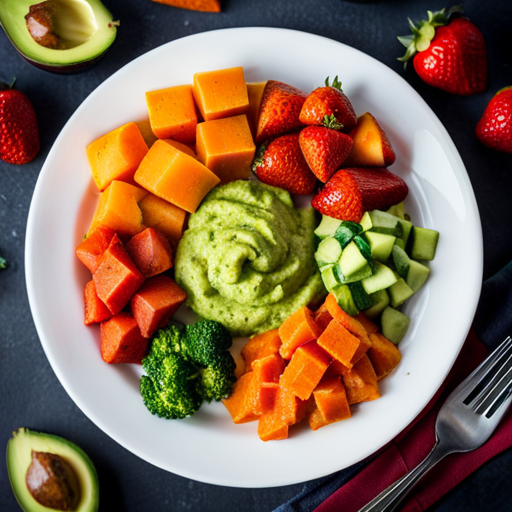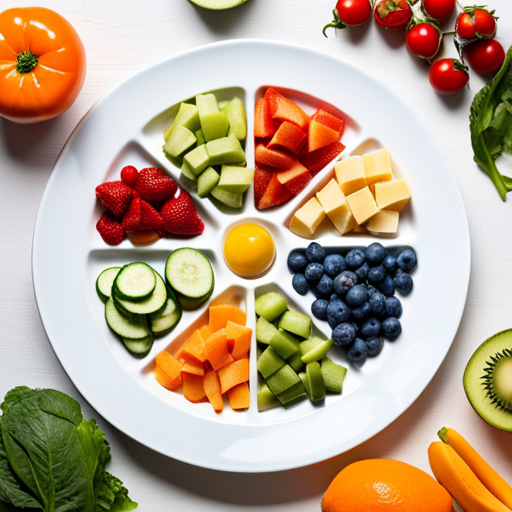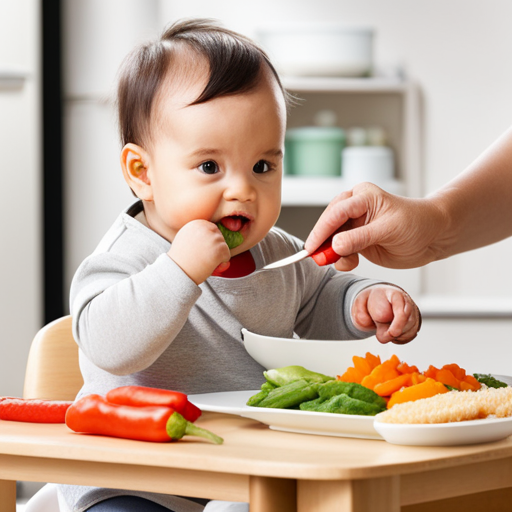"Cherishing Little Steps - A Haven for Baby and Family Journeys"
Feed a 10-Month-Old
Are you ready to embark on the exciting journey of feeding your 10-month-old? As the saying goes, ‘You are what you eat,’ and this is especially true for your little one. Feeding a 10-month-old is an important milestone that requires your love, attention, and understanding.
In this guide, we will provide you with valuable tips and insights on when and how to introduce solids, nutritious foods to include in your baby’s diet, managing portion sizes, and dealing with picky eating. We will also share safety tips to ensure a safe and enjoyable feeding experience for both you and your growing baby.
Get ready to nourish your little one with love and care as you embark on this incredible journey together.
Key Takeaways
- Introduce solids and allergenic foods cautiously, starting with single-ingredient foods and monitoring for potential allergies
- Offer a variety of nutritious foods such as fruits, vegetables, protein-rich foods, whole grains, and dairy products
- Manage portion sizes and feeding frequency based on the baby’s appetite and needs, avoiding overfeeding
- Deal with picky eating by offering a variety of textures and flavors, being patient with acceptance of new foods, and encouraging exploration and acceptance of new tastes
Introducing Solids: When and How to Start

You should start introducing solids to your 10-month-old baby. At this stage, your baby’s digestive system is more mature and they’re ready to explore new tastes and textures. But how do you know if your baby is ready? Look out for signs of readiness such as sitting up with support, showing an interest in your food, and being able to move food from the front of their mouth to the back. These are good indicators that your baby is ready for solids.
When introducing solids, it’s important to start with single-ingredient foods, such as pureed vegetables or fruits. This allows you to identify any potential allergies or intolerances. Speaking of allergies, it used to be recommended that allergenic foods, like peanuts and eggs, be avoided until later in childhood. However, recent research suggests that introducing these foods early, between 4 and 6 months of age, may actually reduce the risk of developing allergies.
To introduce allergenic foods, start with a small amount and watch closely for any adverse reactions. It’s also a good idea to introduce these foods one at a time, waiting a few days in between, to monitor for any potential allergies.
Nutritious Foods for a 10-month-old

When introducing solids to your 10-month-old, it’s important to offer a variety of nutritious foods to support their growing needs. As they transition to more solid foods and develop their chewing skills, you can begin introducing healthy meal options and finger foods to their diet.
Here are some ideas to help you provide a balanced and nutritious diet for your little one:
-
Soft fruits and vegetables: Offer mashed or pureed versions of fruits like bananas, avocados, and cooked sweet potatoes. These are nutrient-dense options that provide vitamins, minerals, and fiber.
-
Protein-rich foods: Introduce small, soft pieces of cooked chicken, turkey, or fish. You can also offer well-cooked legumes like beans or lentils, which are excellent sources of protein and iron.
-
Whole grains: Include cooked grains like oatmeal, quinoa, or rice in your baby’s diet. These grains provide energy and important nutrients such as B vitamins and fiber.
-
Dairy products: If your baby has been introduced to dairy, you can offer small amounts of yogurt or cheese. These are good sources of calcium and protein.
Remember to always supervise your baby during mealtime and offer age-appropriate foods that are soft, easy to chew, and cut into small pieces to prevent choking hazards.
Managing Portion Sizes for Your Growing Baby

You need to manage portion sizes to ensure your growing baby is getting the right amount of food. It’s important to strike a balance between providing enough nutrients for healthy growth and avoiding overfeeding, which can lead to obesity and other health issues later in life. When introducing finger foods, it’s essential to be mindful of managing portion sizes appropriately.
One aspect to consider when managing portion sizes is the potential for food allergies. Introducing new foods one at a time can help identify any allergic reactions. Start with a small amount and gradually increase the portion size if there are no adverse reactions. This approach allows you to monitor your baby’s tolerance and helps identify any potential food allergies early on.
Another consideration is offering a variety of finger foods to encourage independent eating skills. However, it’s important to remember that finger foods shouldn’t replace breast milk or formula as the primary source of nutrition. These foods should be offered as a supplement to ensure that your baby is getting all the necessary nutrients.
As your baby grows, their appetite will naturally increase. Pay attention to their hunger cues and offer appropriate portion sizes accordingly. Remember that every baby is unique, so it’s essential to observe and respond to their individual needs.
Dealing With Picky Eating at This Stage

To address picky eating at this stage, it’s important to be mindful of the food choices you offer your 10-month-old. Here are some strategies to help you deal with texture issues and introduce new flavors:
-
Variety is key: Offer a wide range of textures and flavors to your baby. This will help them develop their taste preferences and get accustomed to different types of foods.
-
Be patient: It’s common for babies to reject new foods at first. It may take several attempts before they accept a new taste or texture. Keep offering a variety of foods and be patient with their response.
-
Mix it up: Try combining new flavors with familiar ones. For example, if your baby enjoys mashed bananas, you can mix in a small amount of pureed spinach or avocado to introduce new flavors.
-
Get creative: Experiment with different cooking methods to change the texture of foods. For example, you can steam, bake, or puree vegetables to offer a variety of textures for your baby to explore.
Safety Tips for Feeding a 10-Month-Old

Ensure the safety of your 10-month-old while feeding by following these important tips.
When it comes to feeding your little one, it’s crucial to be aware of potential choking hazards. Avoid foods such as whole grapes, nuts, popcorn, and chunks of meat or cheese, as they can easily block your baby’s airway. Instead, opt for soft, easily mashed or pureed foods to minimize the risk.
Introducing allergenic foods can be a concern for many parents. It’s recommended to introduce these foods one at a time, waiting a few days before introducing a new one. This way, you can monitor your baby for any allergic reactions or sensitivities. Common allergenic foods include eggs, peanuts, tree nuts, dairy, wheat, soy, and shellfish. Start with a small amount and watch for any signs of an allergic reaction, such as rash, swelling, or difficulty breathing. If you have a family history of food allergies, it may be wise to consult with your pediatrician before introducing allergenic foods.
Always supervise your baby during mealtime and make sure they’re sitting upright in a highchair or booster seat. Avoid distractions such as screens or toys, as they can increase the risk of choking. Cut food into small, manageable pieces and encourage your baby to chew thoroughly before swallowing.
Frequently Asked Questions
What Are Some Signs That My Baby Is Ready to Start Eating Solids?
When your baby is ready to start eating solids, there are some signs to look out for, such as sitting up with support, showing interest in your food, and being able to chew and swallow. Introducing textures gradually can help them adjust.
How Often Should I Feed My 10-Month-Old Solid Foods?
Feeding your 10-month-old solid foods is important for their growth and development. You should aim for a feeding schedule of three meals a day, gradually introducing new flavors to expand their palate.
Can I Introduce Allergenic Foods to My Baby at This Age?
You can introduce allergenic foods to your 10-month-old, but it’s important to follow safety guidelines. Research shows that early introduction may actually reduce the risk of food allergies later in life.
How Do I Know if My Baby Is Getting Enough Nutrients From Solid Foods?
Are you wondering if your little one is getting enough nutrients from solid foods? Assess their nutrient intake by offering a variety of age-appropriate foods and monitoring their developmental milestones. Trust your instincts and consult with a pediatrician if you have any concerns.
What Are Some Strategies for Encouraging My Picky Eater to Try New Foods?
You want your picky eater to try new foods. Encouraging their eating habits and dealing with food aversions can be challenging. Here are some strategies that can help you introduce new foods and make mealtime more enjoyable for your toddler.
Conclusion
In conclusion, feeding a 10-month-old requires introducing nutritious foods, managing portion sizes, and dealing with picky eating.
It’s important to start solids at the right time and in the right way to ensure your baby’s nutritional needs are met.
Remember to prioritize safety while feeding your little one.
Just like a puzzle coming together, proper feeding practices will help your baby grow and thrive.


